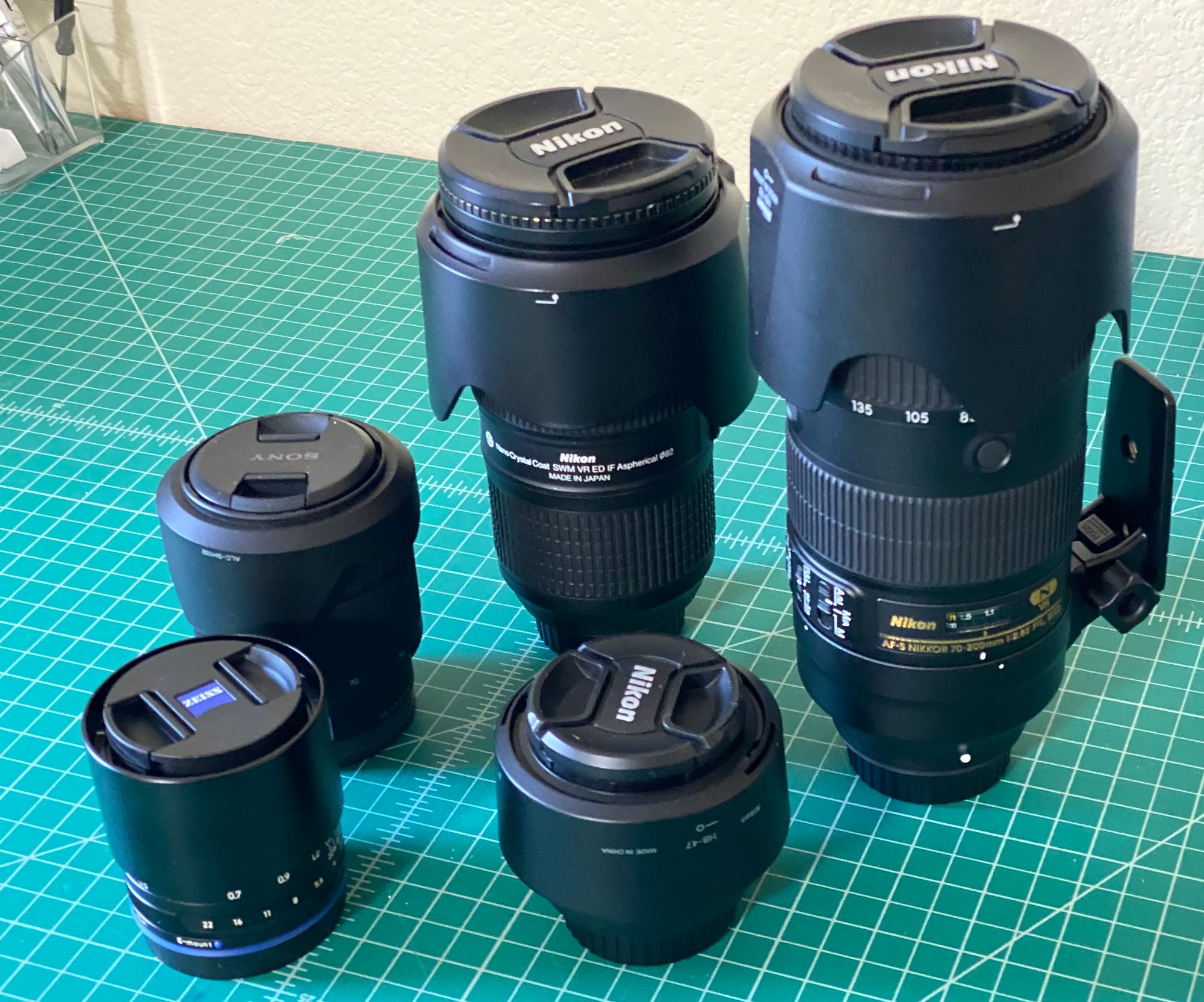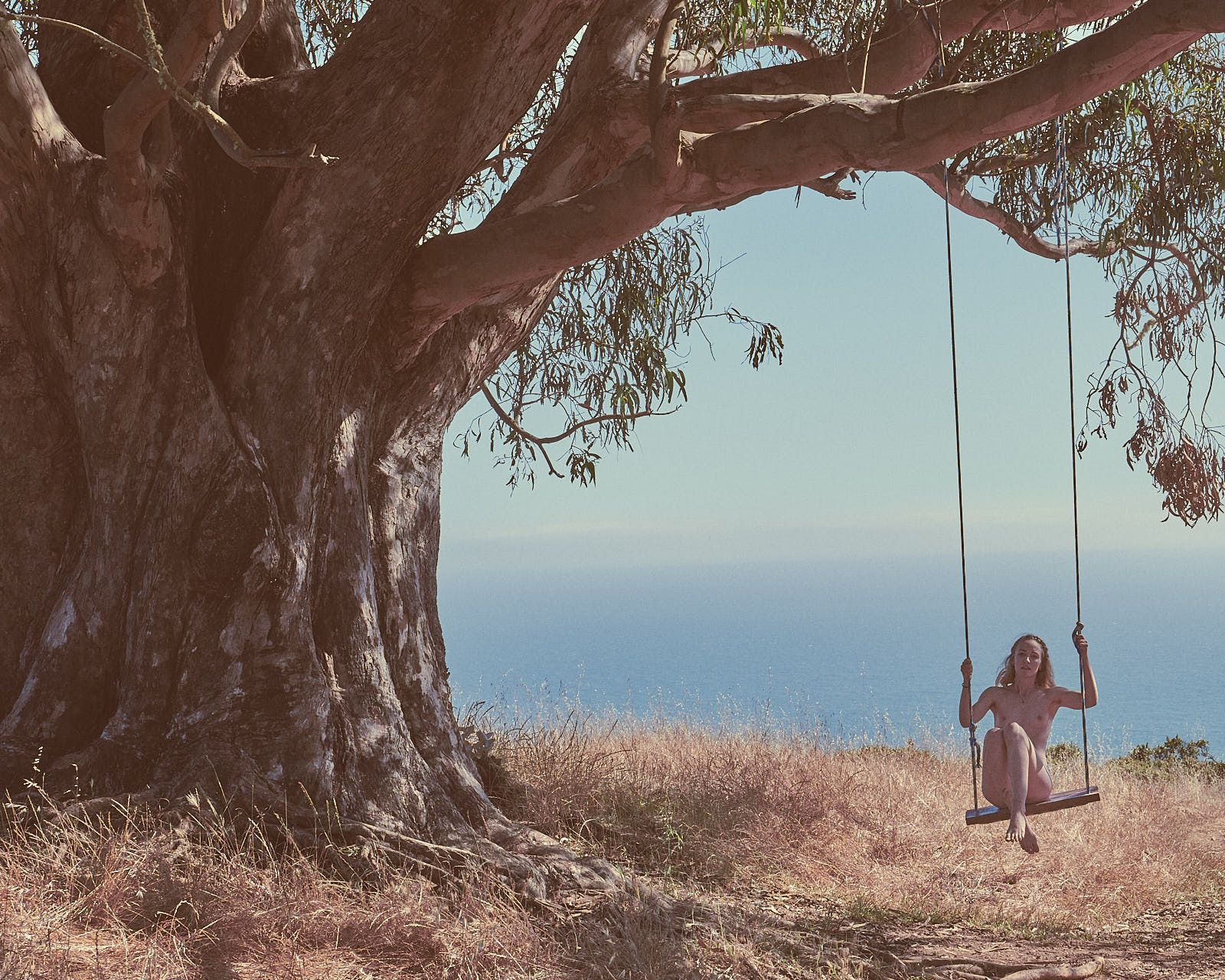
Once you’ve settled on a camera body, the next must-have purchase before you can get started shooting is a lens. There’s a lot to know about lenses, so buckle up and I’ll try and make some sense out of it for you.
Focal Length
Lenses come in a wide variety of “focal lengths”, which is an indication of the field of view that you can capture with the lens. Focal length is specified in millimeters, and is a measure of the distance between the lens and the image sensor or film plate when the subject is in focus.
Lower focal lengths are referred to as “wide angle” lenses because they let you take pictures that includes more of a scene, while high numbers are called “telephoto”, and let you take clear pictures of things that are some distance away. A lens that has a greater focal length than wide angle but less than telephoto is considered a “normal” or “standard” lens, since they are (roughly) equivalent to the field of view of the human eye.
The actual field of view for a lens is determined by both its focal length and the size of the sensor or film frame it’s being used with, which means that a 50mm lens on a full frame camera gives a different field of view than a 50mm lens on a crop sensor camera which gives a different field of view than a 50mm lens on a medium format camera.
The following table gives the approximate ranges of focal distances for wide angle and telephoto lenses for several common sensor sizes.
| Sensor Size | Wide Angle | Telephoto |
|---|---|---|
| CX | <= 13mm | >= 31mm |
| Micro 4/3 | <=17.5mm | >= 42.5mm |
| APS-C | <= 20mm | >= 65 mm |
| APS-H | <= 27mm | >= 50mm |
| Full Frame / 35mm | <= 35mm | >= 85mm |
| Medium Format (645) | <= 56mm | >= 137mm |
| Medium Format (Hasselblad) | <= 64mm | >= 245mm |
To keep things simple, I’m going to express focal lengths in “full-frame equivalents” in rest of this post. If I refer to a “50mm” lens, I mean “50mm on a full frame camera or an equivalent lens on another body, such as a 38mm lens on an APS-H camera (1.7 crop factor), or 29mm lens on an APS-C camera (1.3 crop factor)”.
Prime vs. Zoom
There are two types of lenses available: prime and zoom. A prime lens has a single, fixed focal length, like 50mm, or 85mm. With prime lenses, if you want to include more or less of the scene in your image, you have to physically move further from or closer to your subject. The other type of lens is the zoom lens, which covers a selectable range of focal lengths such as 24-70mm, or 70-200mm. Zoom lenses give you a lot more options to frame your photo without having to physically move to a new location.
Traditional logic said that prime lenses are higher quality and that zoom lenses are a compromise for convenience, with the trade-off being that the images aren’t as sharp and are more prone to various forms of distortion. That traditional logic doesn’t really have much value these days, however. The majority of lenses made and sold now are zoom lenses because we reached a point several years ago where the image quality from a good zoom lenses became virtually indistinguishable from that of prime lenses.
If that’s true, you might be wondering why prime lenses are still made. The primary reason is that prime lenses are less expensive for comparable quality and focal distance, especially for “fast” lenses with an ƒ rating of 2.8 or less. While a professional grade 24-70mm ƒ2.8 lens might run you upwards of $1600, you can get a professional-grade 50mm ƒ1.8 lens for about $150.
A “faster” lens has a lower ƒ-rating and handles low light situations better.
Consumer vs. Professional
The cost of a lens is influenced by many factors, including the focal length and ƒ-rating, but the biggest impact on the price of a lens is the distinction between lenses targeted at consumers, and those targeted for professional use. There’s also a group of lenses that fall in between the two that are sometimes referred to as “prosumer” lenses.
Most professional-grade lenses are designed for full-frame or medium-format bodies, while nearly all consumer lenses are built for smaller “crop” sensor bodies. As smaller sensors have gotten better, we’ve started to see more professional quality glass being made for crop-sensor bodies, but it’s still pretty uncommon to find consumer-grade lenses made for full-frame and medium-format bodies, so if you opt for a larger sensor, expect to pay more (probably considerably more) for your lenses.
To give an example of just how much of a difference in price you can expect to see between consumer and professional lenses, let’s look at a common workhorse, “normal” zoom lens that runs from slightly wide angle to slightly telephoto, such as a 24-70mm or 24-85mm lens.
Note: the field of view on an 18-55mm APS-C lens is roughly equivalent to 24-70mm with a full frame lens
Here is a selection of DSLR lenses, all from the same manufacturer (Nikon), all with roughly the same focal length. The range of prices and features you see here is similar to other manufacturers’ lens lineups for both DSLR and mirrorless cameras:
| Lens Type | Lens | Sensor | MSRP (7/2020) |
| Pro | AF-S Nikkor 24-70mm ƒ2.8 ED VR | Full Frame (FX) | $2099.95 |
| Pro | AF-S Nikkor 24-70mm ƒ2.8 ED | Full Frame (FX) | $1599.95 |
| Prosumer | AF-S Nikkor 24-85mm ƒ2.8-4 IF | Full Frame (FX) | $744.95 |
| Prosumer | AF-S Nikkor 24-85mm ƒ3.5-4.5G ED VR | Full Frame (FX) | $499.95 |
| Consumer | AF-P DX Nikkor 18-55mm ƒ2.5-5.6G VR | APS-C (DX) | $249.95 |
| Consumer | AF-S DX Zoom-Nikkor ED 18-55mm ƒ3.5-5.6G | APS-C (DX) | $199.95 |
| Consumer | AF-S DX Zoom-Nikkor 18-55mm ƒ/3.5-5.6G ED II | APS-C (DX) | $119.95 |
That’s a pretty substantial range of prices for lenses with about the same basic field of view and functionality! The most expensive lens on the list is 17 times more expensive than the least.
If you’re looking to get started on a budget, the lower prices of the consumer lenses are going to be really appealing. The most expensive lens in the list for a crop sensor is $249.95, about a tenth of the price of the most expensive. Going back to my previous post in this series, crop sensor cameras aren’t just less expensive when initially buying the body. The lenses and some of the other accessories are also considerably less expensive, meaning you can often get a lot more bang for your buck with a crop-sensor camera, but your lens selection is going to be more limited, and most of the available lenses will be consumer grade.
You’re probably wondering what you’re going to miss out on if you buy less expensive consumer-grade lenses.
The main differences between professional and consumer lenses are as follows:
- Construction & Repairability: Professional lenses are designed for full-time working photographers, so they’re made to take a beating and keep on working. They feature metal structural components and high-quality ground glass lens elements. Treated well, these lenses will work literally for decades. Consumer lenses, on the other hand, use more plastic components and lower-end consumer lenses may use polycarbonate lens elements rather than glass. Professional lenses are often repairable, but with consumer lenses, it’s usually more cost-effective to replace a lens if it breaks or gets damaged.
- Optics: Consumer lenses are more likely to use plastic or lower quality glass for the optical elements, whereas professional lenses almost always use high-grade ground glass lenses that use extra-low dispersion glass. This means professional lenses will tend to be sharper across all ƒ-stop values, but the difference will be most noticeable in low light situations where the aperture is wide open. Professional lenses also are also far less likely to suffer noticeably from problems such as chromatic aberration, ghosting, and flaring.
- Aperture: In large part because they use better optical components, professional lenses tend to be “faster” lenses with a lower ƒ-stop rating, meaning they let in more light and allow you to get better pictures with less light. If you look at the chart above, all the professional grade lenses have a fixed ƒ-rating of 2.8, meaning they can shoot at that value at all focal lengths. The prosumer lenses have ƒ-ratings that come in a range, meaning the camera’s ƒ-rating increases as you zoom out to longer focal lengths. The consumer lenses also give their ƒ-rating as a range, and a larger range at that, meaning as you zoom out, your lens becomes “slower”, and requires even more light to get good shots.
- Weather Resistance: The higher quality construction often means that professional lenses can handle significantly harsher weather conditions without experiencing problems like condensation on the internal lens elements. It should be noted, however, that just because a lens is professional grade, does not mean it is weather proof or water proof, and you should take precautions to protect your gear whenever you shoot in inclement weather..
- Size & Weight: This is something I didn’t realize before I bought my first professional grade lens, but professional lenses—especially zoom lenses—are much bigger and much heavier than comparable consumer lenses. The cheapest lens in the chart above weighs 7.4 oz, is 2.4 inches in diameter, and 2.9 inches long. The most expensive lens in the list is 38.4 oz, 3.4 inches in diameter, and 6 inches long. That means the most expensive lens is literally five times as heavy and over twice as long as the cheapest, despite having nearly identical focal lengths. The size difference is so dramatic that a lot of professional photographers will buy less expensive “vacation lenses” or “walking-around lenses” so they have something lighter and smaller to use in situations where they don’t need professional-grade glass.
Are these benefits worth the much higher price? That depends on your needs and your budget. For most working professionals and many serious enthusiasts who can afford them, the answer is a resounding yes. While they are expensive, they tend to last a long time. Often, you can use them for years on different camera bodies, with the lens retaining significant resale value even after years of use. If you ever have to shoot in difficult lighting situations, the lower ƒ-rating and better optics are really valuable, and if you ever shoot in tough weather conditions, it’s nice not having to worry quite as much about whether your equipment will survive and your pictures will come out well.
The fact that consumer lenses are “slower” than professional lenses is far less of an issue than it used to be in the film and early digital days where a few ƒ-stops could be the difference between being able to get a good shot and not. With a modern digital camera, you can often compensate for those few extra ƒ-stops by simply adjusting your camera’s ISO rating. You will degrade the quality of your images a bit, but increasing ISO by one or two stops won’t usually be noticeable unless you blow up your photos super large, and you can often compensate for some of that quality loss using a variety of post processing techniques.
You can get amazing images with consumer or prosumer equipment (or, hell, even your phone), so if you’re shooting for yourself, it’s really a matter of how much you’re willing and able to spend and whether you’ll ever be shooting in conditions where the benefits of a professional lens will even matter. In bright daylight, or in a studio with strobes, you’ll barely notice a difference, and if your intention isn’t to shoot professionally, the additional cost of professional gear may very well not be worth it for you, even if you can afford it.
Buying Used
Just like with camera bodies, you can get used gear at a lower price than new, sometimes substantially less. A lot of people get into photography, and then don’t find time for it and end up selling their equipment. Other times, people decide to switch systems, upgrade their gear, or just find that they don’t use certain lenses very often.
As with camera bodies, I wouldn’t generally recommend buying used consumer-grade lenses, but professional lenses and some prosumer lenses are built solidly enough that buying used can be a great option, just make sure you get to test the lens before buying it to make sure there are no scratches or other problems with the optics. Unlike camera bodies, the age of the lens really doesn’t matter all that much as long as the lens has been cared for and maintained and has the right mount for your camera body. An older lens with good optics and no damage to the focus or zoom mechanisms will take just as good pictures as a new lens.
First vs. Third Party
Every camera manufacturer produces (or partners with another company to produce), a line of lenses for their cameras. These “first party” lenses are not the only option. There are companies out there, such as Sigma, Zeiss, and Tamron, that produce lenses for other manufacturer’s cameras.
First party lenses are typically very high quality, and they’re often the only lenses that people look at. However, when buying lenses from your camera’s manufacturer, you usually pay at least some premium. Third party lenses come in a wide variety of price points and quality, so you have to be careful when comparing lenses from different manufacturers, but it is often possible to get a comparable quality lens for less money by going with a third party option.
To give an example, the Sigma ART 24-70mm ƒ/2.8 lens is very highly regarded as a fast, sharp professional lens, in the same ballpark in terms of image and build quality as the AF-S Nikkor 24-70mm ƒ2.8 ED lens from the list above. The Nikkor lens has an MSRP of $1,599.95 with a street price of around $1,450, while the Sigma has an MSRP of $1,299.00 and a street price of about $1,000, which amounts to about a 1/3 savings.
Which Lens or Lenses to Buy
So… the $64 question: which lens or lenses should you buy?
Among photographers I’ve met, there seems to be two schools of thought when it comes to buying lenses. One school of thought is that every lens has a use, and you should buy all the lenses your budget can handle as you have a need for them. The other school of thought says that zoom lenses have gotten so good, there really are only three lenses most photographers will ever need: a good ultrawide-angle zoom, like a 14-24mm, a “normal” zoom, such as a 24-70mm, and a telephoto zoom, such as a 70-200mm.
If you’re not shooting large groups of people, architectural interiors, or landscape panoramas, I would even argue that the ultrawide-angle zoom is only rarely necessary.

Personally, I subscribe to the “most photographers only need a few lenses” school of thought. But… I also think that having a few high quality prime lenses in addition, can be a great investment. Probably 60% of what I shoot is with a 24-70mm lens, with maybe another 30% being shot with a 70-200mm. The remaining 10% are shot with a prime lens like a 50mm ƒ1.4, (aka the “nifty fifty”) or an 85mm ƒ/1.8 (sometimes called a “portrait prime”). Using a fast prime lens allows you to shoot below ƒ2.0, which can make it easier to achieve a desirable effect for portraits and head shots called “bokeh”.

I’ll talk about bokeh in great detail in a later post, but you don’t have to have a super fast prime lens to get a nice bokeh effect. You do need either a fast normal or wide angle lens, or a moderately fast telephoto lens, however, so if you can’t afford a fast zoom like a 24-70mm ƒ/2.8, then a fast 50mm or 85mm prime lens can be a great, and relatively inexpensive option for shooting portraits.
For shooting nudes, you’ll only need an ultra wide-angle lens if you’re going be shooting nudes as a small part of a larger scene, where your subject just one part of the overall landscape, or to shoot full body images in cramped spaces. For most photographer, an ultra wide is not a good choice for a first lens.
Similarly, while telephoto lenses can yield lovely portraits, they make it difficult to shoot in many common situations. Even in a good size studio, it may not be possible to shoot full length photos using a telephoto lens.
Most of the time, if you’ll be focusing on one person, or a few people, and maybe not even shooting full body shots, the best choice for a first lens is going to be either a zoom lens that includes the “normal” range such as a 24-70mm or 24-85mm, or a standard prime lens like a 50mm or 85mm.